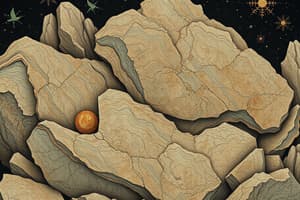Podcast
Questions and Answers
Which of the following rocks is typically used as an aggregate due to its hardness?
Which of the following rocks is typically used as an aggregate due to its hardness?
- Granite (correct)
- Limestone
- Slate (correct)
- Shale
What is the primary purpose of slag in industrial processes?
What is the primary purpose of slag in industrial processes?
- To produce gemstones
- For preservation of ancient artifacts
- As a waste material in ore treatment (correct)
- To enhance the strength of concrete
Which of the following materials is considered a waste product from metal production?
Which of the following materials is considered a waste product from metal production?
- Slag (correct)
- Marble
- Quartzite
- Gneiss
Which of these is NOT a type of rock mentioned as an aggregate material?
Which of these is NOT a type of rock mentioned as an aggregate material?
Which of the following minerals is directly associated with the production of copper?
Which of the following minerals is directly associated with the production of copper?
What is the size of particles defined as coarse aggregate?
What is the size of particles defined as coarse aggregate?
Which of the following best describes pit run aggregate?
Which of the following best describes pit run aggregate?
In the context of aggregate classification, what size is considered when distinguishing coarse aggregate?
In the context of aggregate classification, what size is considered when distinguishing coarse aggregate?
Which of the following is NOT a characteristic of pit run aggregate?
Which of the following is NOT a characteristic of pit run aggregate?
Why is coarse aggregate important in construction?
Why is coarse aggregate important in construction?
What percentage of Sample 1 is blended to achieve the final product?
What percentage of Sample 1 is blended to achieve the final product?
What is the combined percentage of the sizes in the blending sample for size 9.5 mm?
What is the combined percentage of the sizes in the blending sample for size 9.5 mm?
Which size does not meet the required specifications based on the blending sample?
Which size does not meet the required specifications based on the blending sample?
What is the percentage contribution of Sample 2 for size 12.5 mm in the blending sample?
What is the percentage contribution of Sample 2 for size 12.5 mm in the blending sample?
What is the total percentage for the blending sample for size 4.75 mm?
What is the total percentage for the blending sample for size 4.75 mm?
What is more important than the strength of aggregate particles in construction?
What is more important than the strength of aggregate particles in construction?
Why are crushed particles preferred over rounded particles?
Why are crushed particles preferred over rounded particles?
How does the friction between crushed particles compare to that of rounded particles?
How does the friction between crushed particles compare to that of rounded particles?
What effect does the shape of aggregate particles have on their behavior?
What effect does the shape of aggregate particles have on their behavior?
In what manner do crushed particles affect load distribution compared to rounded particles?
In what manner do crushed particles affect load distribution compared to rounded particles?
What is the primary process through which igneous rocks are formed?
What is the primary process through which igneous rocks are formed?
Which of the following is NOT an example of an igneous rock?
Which of the following is NOT an example of an igneous rock?
Which of these characteristics is unique to igneous rocks compared to other types of rocks?
Which of these characteristics is unique to igneous rocks compared to other types of rocks?
What type of igneous rock is typically formed from rapid cooling of lava?
What type of igneous rock is typically formed from rapid cooling of lava?
Which igneous rock is most likely to contain larger crystals due to slow cooling beneath the Earth's surface?
Which igneous rock is most likely to contain larger crystals due to slow cooling beneath the Earth's surface?
Flashcards are hidden until you start studying
Study Notes
Bedrock Types
- Igneous rocks are formed from cooling molten material.
- Examples of igneous rocks include granite, basalt, and trap rock.
- Both igneous and metamorphic rocks are typically very hard and make excellent aggregates.
Types of Aggregates
- Coarse aggregate is gravel-sized and consists of particles larger than 4.75 mm.
- Pit run aggregate is untreated sand or gravel from a pit.
Slag
- Slag is a waste material from the processing of ore to produce metals like iron, steel, nickel, copper, and gold.
Blending Aggregates
- A blend of 30% of sample 1 and 70% of sample 2 can meet a specific size specification.
Aggregate Strength
- The strength of individual aggregate particles is less important than the shape of the particles.
- Crushed particles are better than rounded particles because of their higher friction and better load distribution.
Studying That Suits You
Use AI to generate personalized quizzes and flashcards to suit your learning preferences.




